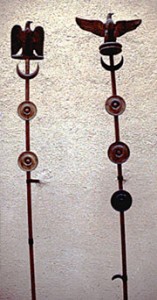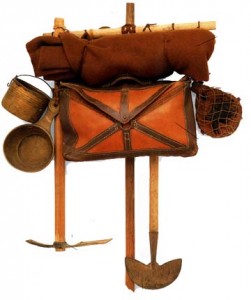I haven’t touched on anything about antiquity for a while so I thought I would put this up as I have been thinking about this for the last week or two. This is the Marian Legion or the Reforms of Marius, whichever you choose to call it.
These reforms are important because they set the stage for the Legion of the period of the Civil War and early Imperium, especially the time of the Pax Romana. These reforms are probably not a direct result of the genius of Gaius Marius, he just gets credit for implementing them. That being said, he is the one who implemented them and turned the Roman Army into a professional force that essentially defeated all comers for the next 300-400 years. They are therefore worth discussing.
The Marian Reforms can essentially be broken down into two types: 1. Administrative and 2. Operational. They are synergistic reforms in that administrative changes affected operations and in fact at some level were driven by them. The most important administrative changes were the elimination of the land requirement and substitution of a citizenship requirement for service and most importantly in my opinion, the state was now responsible for providing uniform equipment. The operational changes were the introduction of the Legionary Eagle, the redesigned pilum, and the elimination of the baggage train.
First let’s discuss administrative changes. The elimination of a land requirement and substitution of a citizenship requirement meant that the army could be substantially enlarged because there was a large number citizens who lived in the city of Rome but owned no land. This was a huge departure from former practice. This actually achieved two things; one, as previously stated it allowed for a huge expansion in the size of the army, secondly it gave the poor in Rome a stake in the success of the Republic. This last part was no small accomplishment The second administrative change was that the state took on the responsibility for providing the Legionnaire’s equipment.  his also accomplished two things.  The first thing this accomplished was that along with the citizenship requirement for service meant that the huge number of potential recruit could be equipped.  Before this change the individual was responsible for providing their own equipment and this was not a minor expense.  I heave read some estimates that a Legionnaires equipment could cost the equivalent of a year’s wages.  This seems fairly reasonable to me if you consider that a modern American soldier’s equipment runs in the neighborhood of $40-50,000.  Eliminating this burden allowed more soldiers to be recruited.  The second and more important change was that it allowed for the standardization of equipment.  This not only brought down costs it also meant that units were more uniform and thus their capabilities became more of a known factor.
Operational changes were at least as important as the administrative changes the Legions underwent.  The introduction of the Eagle, the pilum, and elimination of the legionary baggage train made huge changes.

First, the introduction of the Legionary Eagle.  The Eagle was the standard of the Legion and with its introduction the Legions became permananetn formations and not transitory ones that were raised and disbanded with every campaigning season as had previously been the practice. This gave individual legions a history and traditions.  The Eagle was the personification of this history and tradition.  It helped improve that tenuous concept known as Esprit d’Corps.  It helped soldiers identify with their unit and made them want to fight hard to uphold the units traditions.  It also served as a rallying point for the Legion in Battle.  The loss of an eagle was considered one of the most shameful things that could happen to a unit.  Great deeds of heroism were done to protect the Eagle.  In many ways the Eagle became the unit, it was the manifestation that the unit itself had a life and would continue.  The greatest disgrace that could occur was for a Legion to lose it’s Eagle, this was even worse than defeat.  A unit could be defeated in honorable battle but it was the height of shame when a unit lost it’s Eagle.

The introduction of the Pilum was another of the Marian reforms.  It is difficult for a modern reader to understand the significance of this change.  The Pilum was a spear with some special design elements.  Most importantly, it incorporated a semi-mobile shaft.  It had an articulated head constructed such that when it impacted an enemy shield part sheared off precluding the enemy from throwing it back at the Romans.  There were two pegs connecting the head of the spear to the shaft.  One was iron while the other was wooden.  When the Pilum impacted an enemy shield the wooden peg would break allowing the spear to pivot on the fulcrum of the iron peg.  this meant the the shield was not only useless to be thrown back at the Romans but further it meant that the enemy shield itself became too heavy and unwieldy for use thus forcing them to discard their shield because of the added unbalanced weight added to it. The loss of their shield meant that enemy troops were that much less protected once the Legionnaire got into melee range.  Additionally, the fact that the Pilum beacme the standard Legion stand-off weapon meant that drill in its use could be added to the standard training regimen of the legion.  This not only simplified legion training it meant that if a legionnaire was transferred from one Legion to another he did not have to relearn how to employ  a new weapon that was not used in the Legion from which he came.
The last, and one of the most important changes was the elimination of the Legions baggage train.  To really understand the significance of this change it is necessary to understand the effect of a baggage train on ancient armies.  Typically, armies of the ancient world had a baggage train.  This was not just baggage and equipment for the troops, often, even most of the time, the baggage train was full of what are known as camp followers.  This was a large group of people from families of the soldiers to suttlers, merchants, widows and orphans, and prostitutes.  This group could not move as fast as an army unencumbered because it included wagons as well.  Ancient wagons were generally drawn by Oxen and not horses, and oxen are slow.  The Roman elimination of the baggage train increased he strategic and operational speed of the Roman Legions.

To put it bluntly, with a baggage train an army could march on the order of 5-8 miles per day; without a baggage train they could make 20-25 miles per day or almost 4 times as fast.  To accomplish this Marius made each Legionnaire carry a backpack with the essentials he would need while on the march.  This backpack weighed up to 90 pounds and the legionary was expected to march 20 miles per day carrying it.  This pack led to the nickname for the troops of Marius’ Mules.
The Legionaries carried not just food but also equipment to fortify their camp at the end of each day’s march.  The fact that they could make 20 miles per day meant that the Roman army had an operational mobility that few of their enemies could match.  This let them surprise their enemies by getting to places much faster than any of them thought possible and surprise is one of the most decisive things in warfare.
The various reforms of the Roman army implemented by Marius turned the Roman army from a formidable, seasonal force to a year round, professional force that proved to be virtually unbeatable by it’s enemies.  These reforms wrought changes in the Roman ay f war comparable to those brought about by the introduction of the internal combustion engine in the early 20th cnetury.  The reforms were standardized and modified very little until relatively late in the Imperial period.  They let the Romans outfight and outmarch their opponents an just about every battlefield for almost 500 years.  It is virtually impossible to understand Roman military success without understanding the definitive changes in military practice brought about by the Marian Reforms of the Roman Army.
Further Reading: Marian Reforms, Clio Article, From Republic to Empire: How Revolutionary were the Reforms of Gaius Marius.
